Challenges of Attracting and Retaining Staff in the Retail Industry
VerifiedAdded on 2023/01/13
|9
|3047
|66
Essay
AI Summary
This essay examines the critical aspects of attracting and retaining staff within the Australian retail industry. It delves into five key themes: industrial relations, HR planning in a changing environment, work design challenges in a global environment, talent attraction and selection, and talent retention and development. The essay explores the complexities of employee relations, the impact of workforce planning, and the significance of job design in attracting a diverse workforce. It also discusses effective recruitment channels and talent retention strategies within the context of the retail sector. The analysis highlights the challenges faced by the industry, such as restructuring, fluctuating workforce demands, and the need for flexible work designs, and proposes solutions such as effective HRIMS implementation and strategic recruitment approaches. The essay emphasizes the importance of adapting to changing trends and creating a supportive work environment to ensure business objectives are met and competitive advantages are maintained.
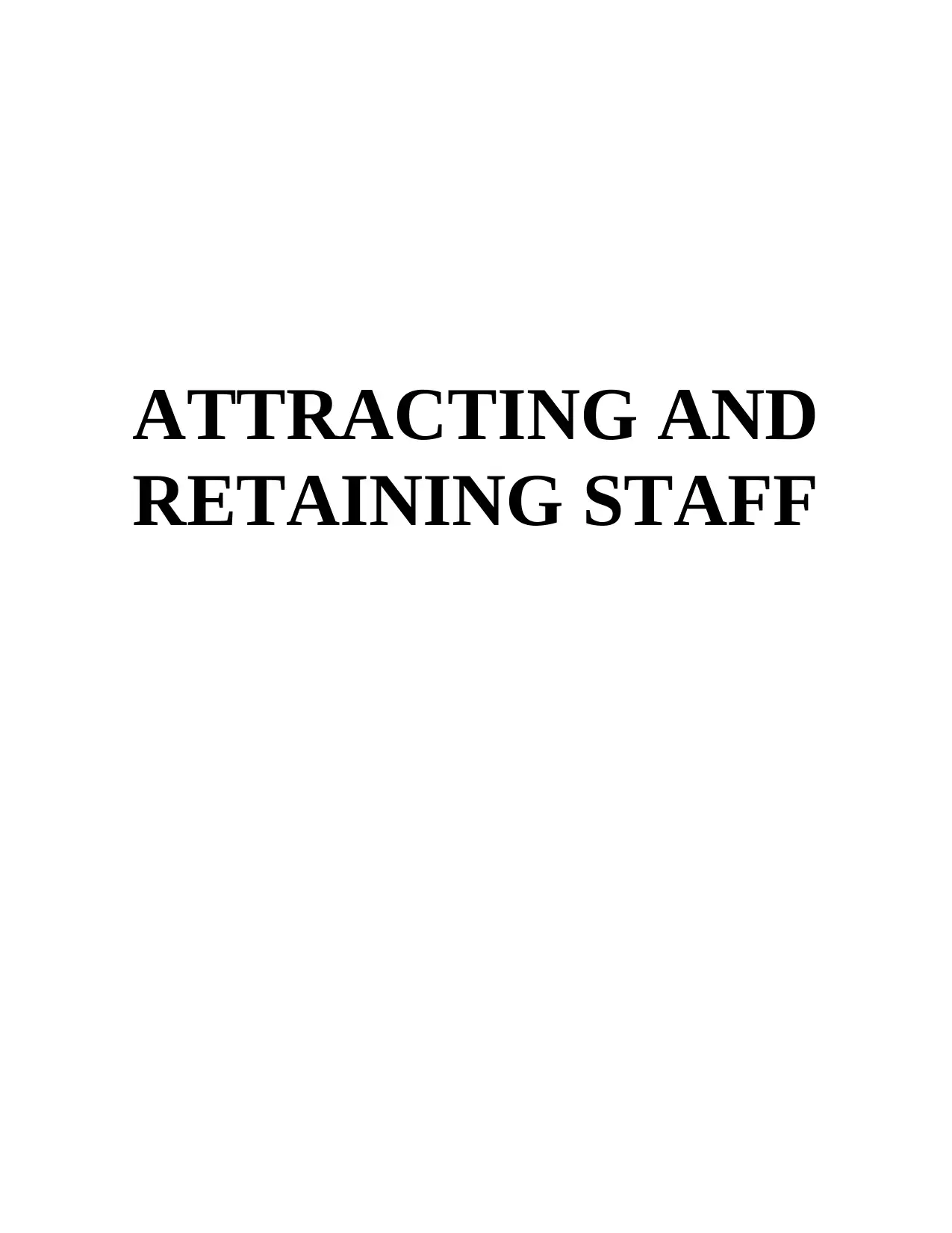
ATTRACTING AND
RETAINING STAFF
RETAINING STAFF
Paraphrase This Document
Need a fresh take? Get an instant paraphrase of this document with our AI Paraphraser
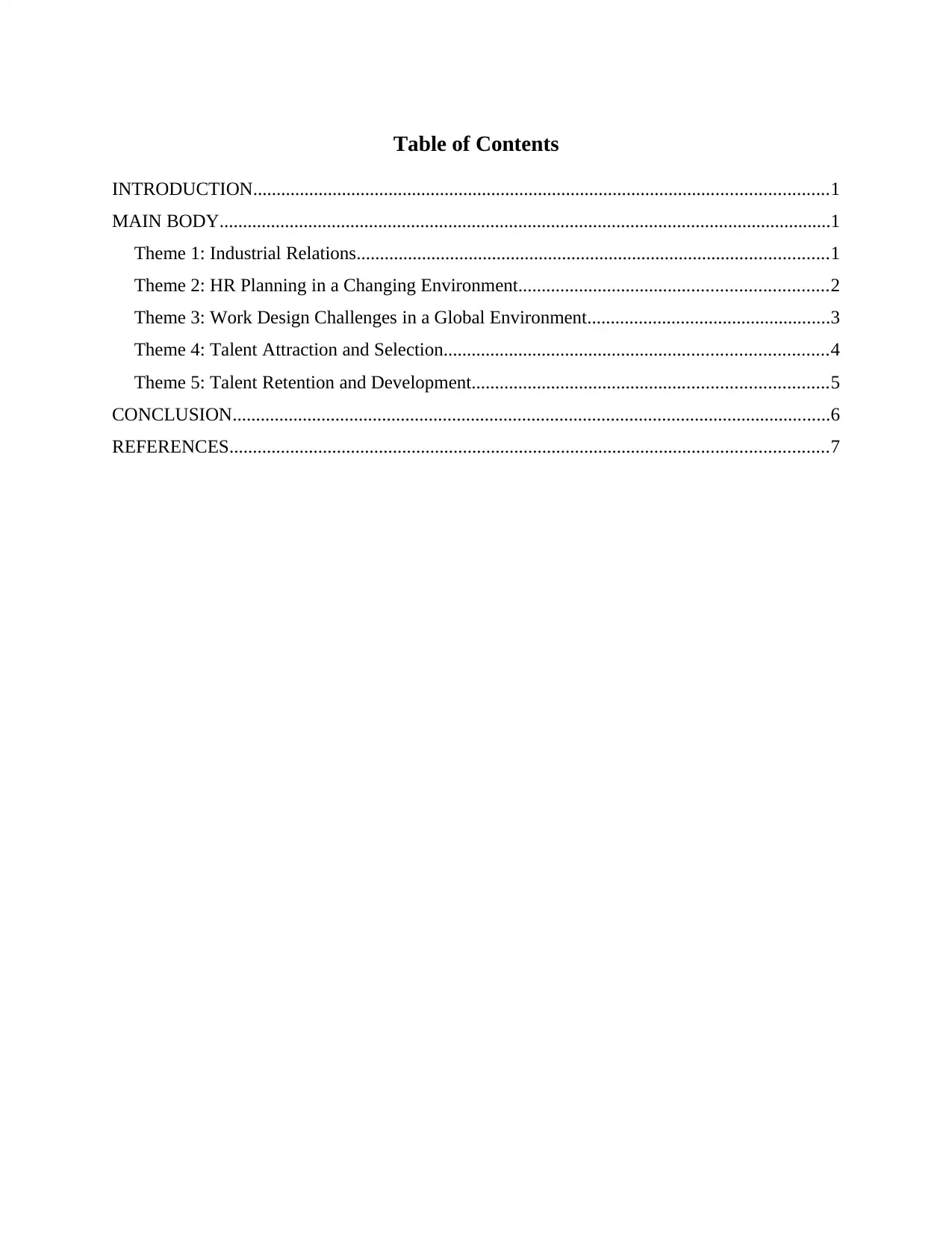
Table of Contents
INTRODUCTION...........................................................................................................................1
MAIN BODY...................................................................................................................................1
Theme 1: Industrial Relations.....................................................................................................1
Theme 2: HR Planning in a Changing Environment..................................................................2
Theme 3: Work Design Challenges in a Global Environment....................................................3
Theme 4: Talent Attraction and Selection..................................................................................4
Theme 5: Talent Retention and Development............................................................................5
CONCLUSION................................................................................................................................6
REFERENCES................................................................................................................................7
INTRODUCTION...........................................................................................................................1
MAIN BODY...................................................................................................................................1
Theme 1: Industrial Relations.....................................................................................................1
Theme 2: HR Planning in a Changing Environment..................................................................2
Theme 3: Work Design Challenges in a Global Environment....................................................3
Theme 4: Talent Attraction and Selection..................................................................................4
Theme 5: Talent Retention and Development............................................................................5
CONCLUSION................................................................................................................................6
REFERENCES................................................................................................................................7
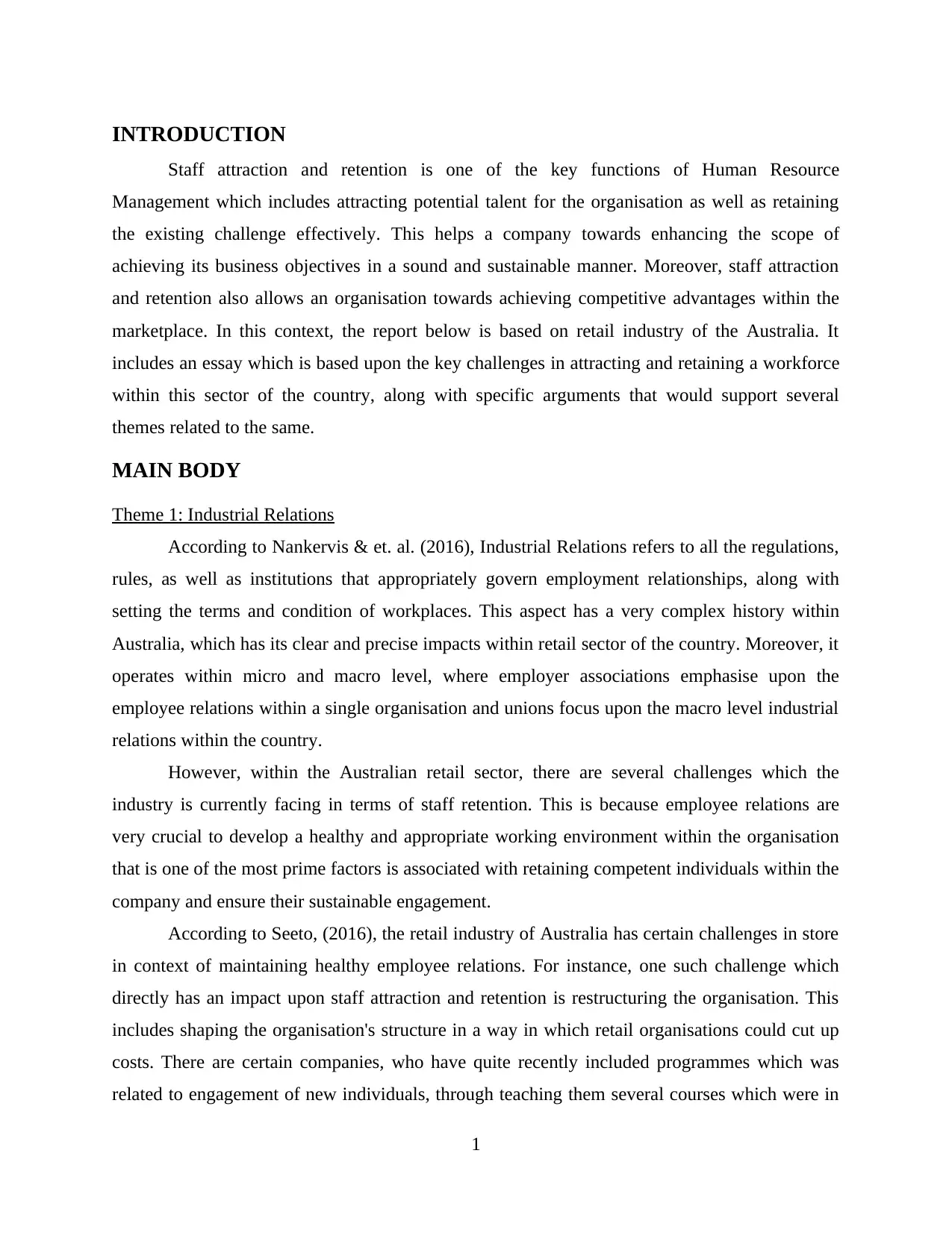
INTRODUCTION
Staff attraction and retention is one of the key functions of Human Resource
Management which includes attracting potential talent for the organisation as well as retaining
the existing challenge effectively. This helps a company towards enhancing the scope of
achieving its business objectives in a sound and sustainable manner. Moreover, staff attraction
and retention also allows an organisation towards achieving competitive advantages within the
marketplace. In this context, the report below is based on retail industry of the Australia. It
includes an essay which is based upon the key challenges in attracting and retaining a workforce
within this sector of the country, along with specific arguments that would support several
themes related to the same.
MAIN BODY
Theme 1: Industrial Relations
According to Nankervis & et. al. (2016), Industrial Relations refers to all the regulations,
rules, as well as institutions that appropriately govern employment relationships, along with
setting the terms and condition of workplaces. This aspect has a very complex history within
Australia, which has its clear and precise impacts within retail sector of the country. Moreover, it
operates within micro and macro level, where employer associations emphasise upon the
employee relations within a single organisation and unions focus upon the macro level industrial
relations within the country.
However, within the Australian retail sector, there are several challenges which the
industry is currently facing in terms of staff retention. This is because employee relations are
very crucial to develop a healthy and appropriate working environment within the organisation
that is one of the most prime factors is associated with retaining competent individuals within the
company and ensure their sustainable engagement.
According to Seeto, (2016), the retail industry of Australia has certain challenges in store
in context of maintaining healthy employee relations. For instance, one such challenge which
directly has an impact upon staff attraction and retention is restructuring the organisation. This
includes shaping the organisation's structure in a way in which retail organisations could cut up
costs. There are certain companies, who have quite recently included programmes which was
related to engagement of new individuals, through teaching them several courses which were in
1
Staff attraction and retention is one of the key functions of Human Resource
Management which includes attracting potential talent for the organisation as well as retaining
the existing challenge effectively. This helps a company towards enhancing the scope of
achieving its business objectives in a sound and sustainable manner. Moreover, staff attraction
and retention also allows an organisation towards achieving competitive advantages within the
marketplace. In this context, the report below is based on retail industry of the Australia. It
includes an essay which is based upon the key challenges in attracting and retaining a workforce
within this sector of the country, along with specific arguments that would support several
themes related to the same.
MAIN BODY
Theme 1: Industrial Relations
According to Nankervis & et. al. (2016), Industrial Relations refers to all the regulations,
rules, as well as institutions that appropriately govern employment relationships, along with
setting the terms and condition of workplaces. This aspect has a very complex history within
Australia, which has its clear and precise impacts within retail sector of the country. Moreover, it
operates within micro and macro level, where employer associations emphasise upon the
employee relations within a single organisation and unions focus upon the macro level industrial
relations within the country.
However, within the Australian retail sector, there are several challenges which the
industry is currently facing in terms of staff retention. This is because employee relations are
very crucial to develop a healthy and appropriate working environment within the organisation
that is one of the most prime factors is associated with retaining competent individuals within the
company and ensure their sustainable engagement.
According to Seeto, (2016), the retail industry of Australia has certain challenges in store
in context of maintaining healthy employee relations. For instance, one such challenge which
directly has an impact upon staff attraction and retention is restructuring the organisation. This
includes shaping the organisation's structure in a way in which retail organisations could cut up
costs. There are certain companies, who have quite recently included programmes which was
related to engagement of new individuals, through teaching them several courses which were in
1
⊘ This is a preview!⊘
Do you want full access?
Subscribe today to unlock all pages.

Trusted by 1+ million students worldwide
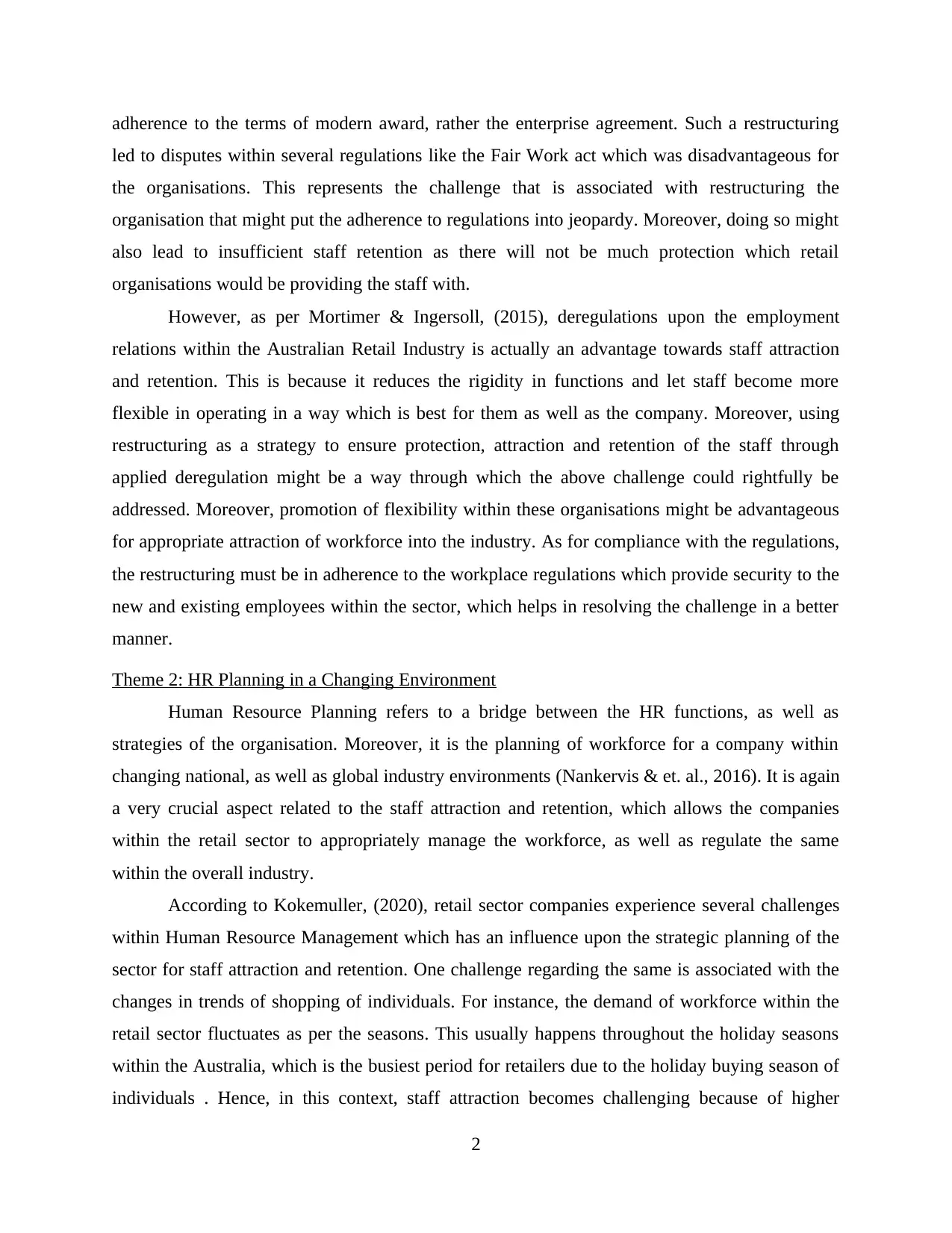
adherence to the terms of modern award, rather the enterprise agreement. Such a restructuring
led to disputes within several regulations like the Fair Work act which was disadvantageous for
the organisations. This represents the challenge that is associated with restructuring the
organisation that might put the adherence to regulations into jeopardy. Moreover, doing so might
also lead to insufficient staff retention as there will not be much protection which retail
organisations would be providing the staff with.
However, as per Mortimer & Ingersoll, (2015), deregulations upon the employment
relations within the Australian Retail Industry is actually an advantage towards staff attraction
and retention. This is because it reduces the rigidity in functions and let staff become more
flexible in operating in a way which is best for them as well as the company. Moreover, using
restructuring as a strategy to ensure protection, attraction and retention of the staff through
applied deregulation might be a way through which the above challenge could rightfully be
addressed. Moreover, promotion of flexibility within these organisations might be advantageous
for appropriate attraction of workforce into the industry. As for compliance with the regulations,
the restructuring must be in adherence to the workplace regulations which provide security to the
new and existing employees within the sector, which helps in resolving the challenge in a better
manner.
Theme 2: HR Planning in a Changing Environment
Human Resource Planning refers to a bridge between the HR functions, as well as
strategies of the organisation. Moreover, it is the planning of workforce for a company within
changing national, as well as global industry environments (Nankervis & et. al., 2016). It is again
a very crucial aspect related to the staff attraction and retention, which allows the companies
within the retail sector to appropriately manage the workforce, as well as regulate the same
within the overall industry.
According to Kokemuller, (2020), retail sector companies experience several challenges
within Human Resource Management which has an influence upon the strategic planning of the
sector for staff attraction and retention. One challenge regarding the same is associated with the
changes in trends of shopping of individuals. For instance, the demand of workforce within the
retail sector fluctuates as per the seasons. This usually happens throughout the holiday seasons
within the Australia, which is the busiest period for retailers due to the holiday buying season of
individuals . Hence, in this context, staff attraction becomes challenging because of higher
2
led to disputes within several regulations like the Fair Work act which was disadvantageous for
the organisations. This represents the challenge that is associated with restructuring the
organisation that might put the adherence to regulations into jeopardy. Moreover, doing so might
also lead to insufficient staff retention as there will not be much protection which retail
organisations would be providing the staff with.
However, as per Mortimer & Ingersoll, (2015), deregulations upon the employment
relations within the Australian Retail Industry is actually an advantage towards staff attraction
and retention. This is because it reduces the rigidity in functions and let staff become more
flexible in operating in a way which is best for them as well as the company. Moreover, using
restructuring as a strategy to ensure protection, attraction and retention of the staff through
applied deregulation might be a way through which the above challenge could rightfully be
addressed. Moreover, promotion of flexibility within these organisations might be advantageous
for appropriate attraction of workforce into the industry. As for compliance with the regulations,
the restructuring must be in adherence to the workplace regulations which provide security to the
new and existing employees within the sector, which helps in resolving the challenge in a better
manner.
Theme 2: HR Planning in a Changing Environment
Human Resource Planning refers to a bridge between the HR functions, as well as
strategies of the organisation. Moreover, it is the planning of workforce for a company within
changing national, as well as global industry environments (Nankervis & et. al., 2016). It is again
a very crucial aspect related to the staff attraction and retention, which allows the companies
within the retail sector to appropriately manage the workforce, as well as regulate the same
within the overall industry.
According to Kokemuller, (2020), retail sector companies experience several challenges
within Human Resource Management which has an influence upon the strategic planning of the
sector for staff attraction and retention. One challenge regarding the same is associated with the
changes in trends of shopping of individuals. For instance, the demand of workforce within the
retail sector fluctuates as per the seasons. This usually happens throughout the holiday seasons
within the Australia, which is the busiest period for retailers due to the holiday buying season of
individuals . Hence, in this context, staff attraction becomes challenging because of higher
2
Paraphrase This Document
Need a fresh take? Get an instant paraphrase of this document with our AI Paraphraser
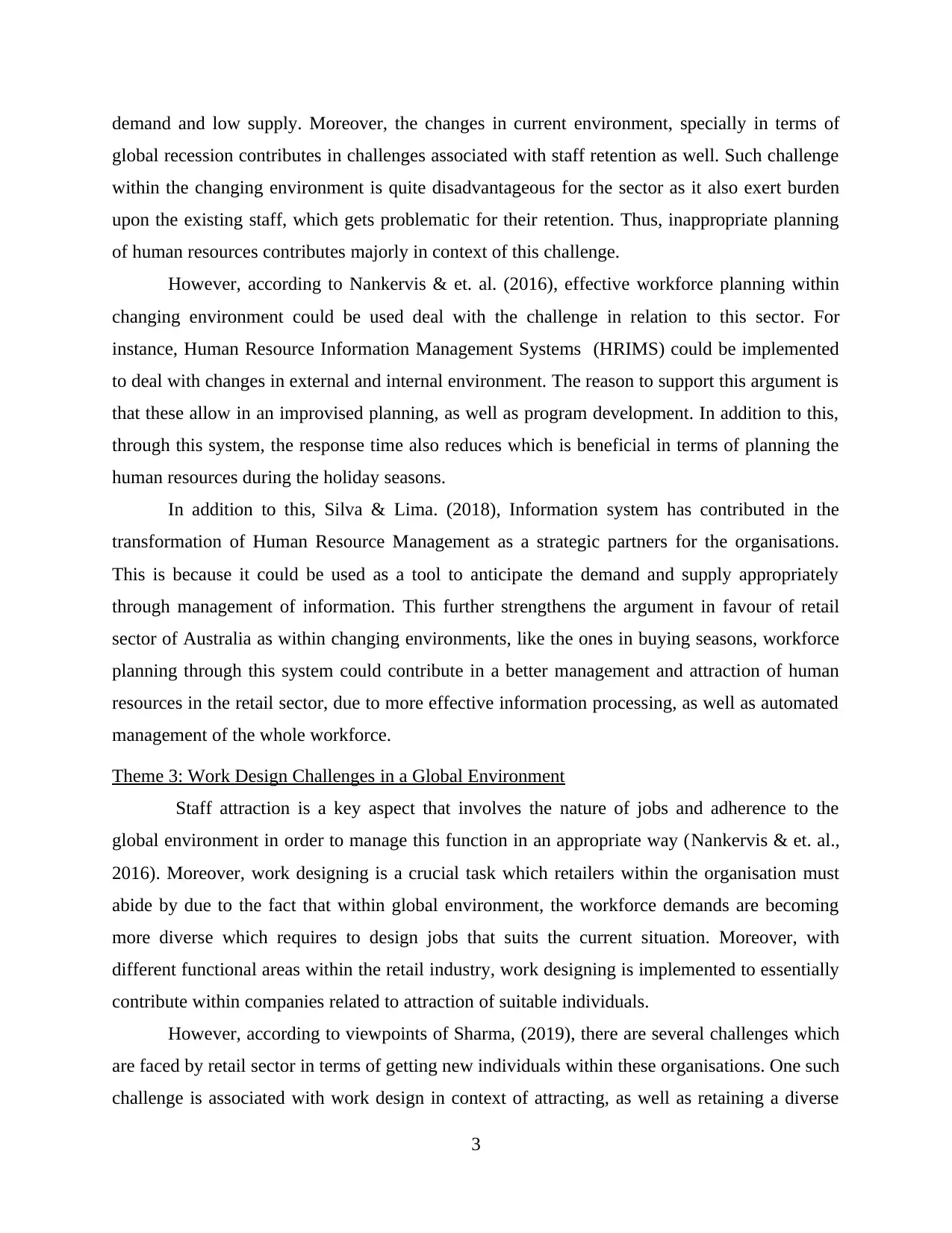
demand and low supply. Moreover, the changes in current environment, specially in terms of
global recession contributes in challenges associated with staff retention as well. Such challenge
within the changing environment is quite disadvantageous for the sector as it also exert burden
upon the existing staff, which gets problematic for their retention. Thus, inappropriate planning
of human resources contributes majorly in context of this challenge.
However, according to Nankervis & et. al. (2016), effective workforce planning within
changing environment could be used deal with the challenge in relation to this sector. For
instance, Human Resource Information Management Systems (HRIMS) could be implemented
to deal with changes in external and internal environment. The reason to support this argument is
that these allow in an improvised planning, as well as program development. In addition to this,
through this system, the response time also reduces which is beneficial in terms of planning the
human resources during the holiday seasons.
In addition to this, Silva & Lima. (2018), Information system has contributed in the
transformation of Human Resource Management as a strategic partners for the organisations.
This is because it could be used as a tool to anticipate the demand and supply appropriately
through management of information. This further strengthens the argument in favour of retail
sector of Australia as within changing environments, like the ones in buying seasons, workforce
planning through this system could contribute in a better management and attraction of human
resources in the retail sector, due to more effective information processing, as well as automated
management of the whole workforce.
Theme 3: Work Design Challenges in a Global Environment
Staff attraction is a key aspect that involves the nature of jobs and adherence to the
global environment in order to manage this function in an appropriate way (Nankervis & et. al.,
2016). Moreover, work designing is a crucial task which retailers within the organisation must
abide by due to the fact that within global environment, the workforce demands are becoming
more diverse which requires to design jobs that suits the current situation. Moreover, with
different functional areas within the retail industry, work designing is implemented to essentially
contribute within companies related to attraction of suitable individuals.
However, according to viewpoints of Sharma, (2019), there are several challenges which
are faced by retail sector in terms of getting new individuals within these organisations. One such
challenge is associated with work design in context of attracting, as well as retaining a diverse
3
global recession contributes in challenges associated with staff retention as well. Such challenge
within the changing environment is quite disadvantageous for the sector as it also exert burden
upon the existing staff, which gets problematic for their retention. Thus, inappropriate planning
of human resources contributes majorly in context of this challenge.
However, according to Nankervis & et. al. (2016), effective workforce planning within
changing environment could be used deal with the challenge in relation to this sector. For
instance, Human Resource Information Management Systems (HRIMS) could be implemented
to deal with changes in external and internal environment. The reason to support this argument is
that these allow in an improvised planning, as well as program development. In addition to this,
through this system, the response time also reduces which is beneficial in terms of planning the
human resources during the holiday seasons.
In addition to this, Silva & Lima. (2018), Information system has contributed in the
transformation of Human Resource Management as a strategic partners for the organisations.
This is because it could be used as a tool to anticipate the demand and supply appropriately
through management of information. This further strengthens the argument in favour of retail
sector of Australia as within changing environments, like the ones in buying seasons, workforce
planning through this system could contribute in a better management and attraction of human
resources in the retail sector, due to more effective information processing, as well as automated
management of the whole workforce.
Theme 3: Work Design Challenges in a Global Environment
Staff attraction is a key aspect that involves the nature of jobs and adherence to the
global environment in order to manage this function in an appropriate way (Nankervis & et. al.,
2016). Moreover, work designing is a crucial task which retailers within the organisation must
abide by due to the fact that within global environment, the workforce demands are becoming
more diverse which requires to design jobs that suits the current situation. Moreover, with
different functional areas within the retail industry, work designing is implemented to essentially
contribute within companies related to attraction of suitable individuals.
However, according to viewpoints of Sharma, (2019), there are several challenges which
are faced by retail sector in terms of getting new individuals within these organisations. One such
challenge is associated with work design in context of attracting, as well as retaining a diverse
3
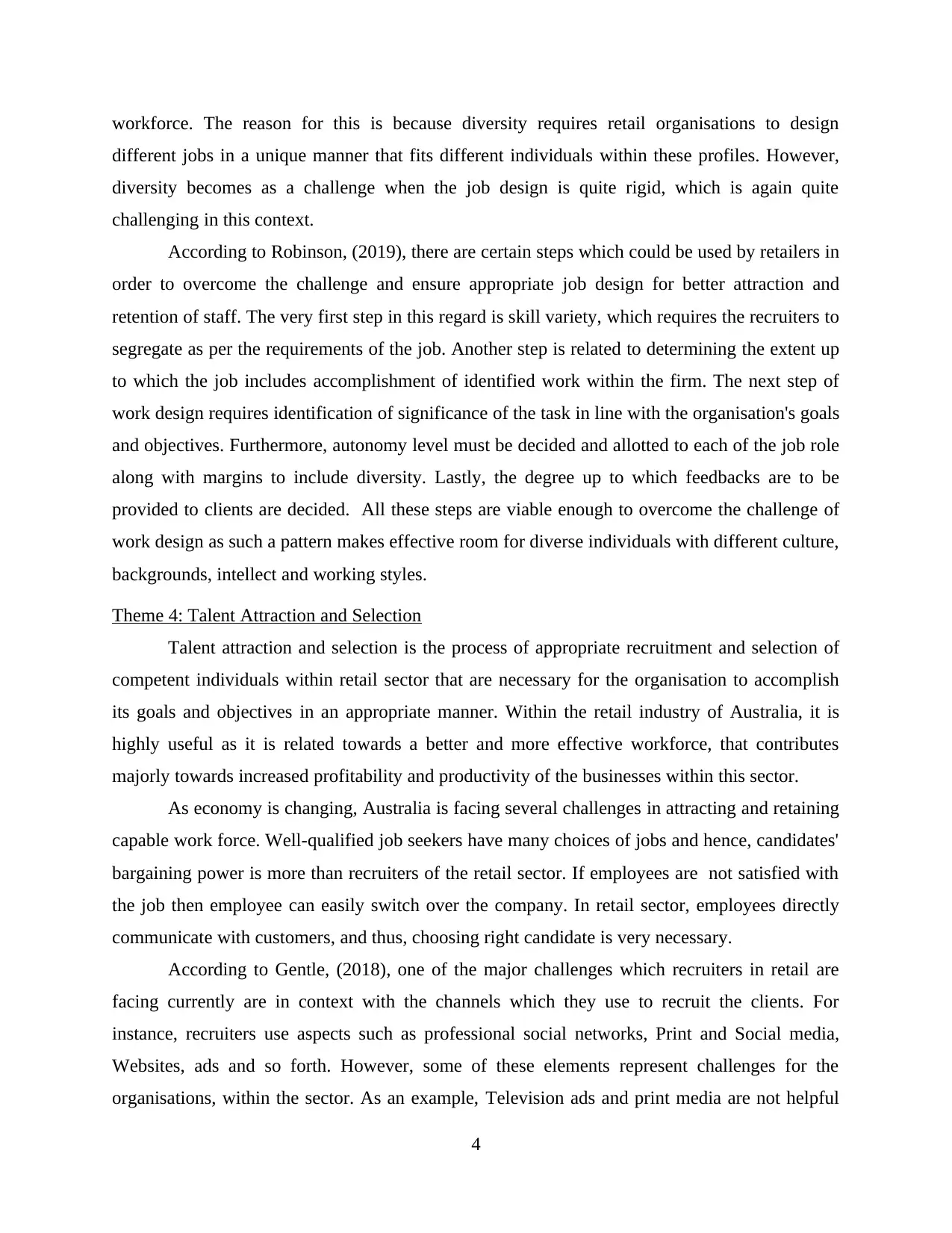
workforce. The reason for this is because diversity requires retail organisations to design
different jobs in a unique manner that fits different individuals within these profiles. However,
diversity becomes as a challenge when the job design is quite rigid, which is again quite
challenging in this context.
According to Robinson, (2019), there are certain steps which could be used by retailers in
order to overcome the challenge and ensure appropriate job design for better attraction and
retention of staff. The very first step in this regard is skill variety, which requires the recruiters to
segregate as per the requirements of the job. Another step is related to determining the extent up
to which the job includes accomplishment of identified work within the firm. The next step of
work design requires identification of significance of the task in line with the organisation's goals
and objectives. Furthermore, autonomy level must be decided and allotted to each of the job role
along with margins to include diversity. Lastly, the degree up to which feedbacks are to be
provided to clients are decided. All these steps are viable enough to overcome the challenge of
work design as such a pattern makes effective room for diverse individuals with different culture,
backgrounds, intellect and working styles.
Theme 4: Talent Attraction and Selection
Talent attraction and selection is the process of appropriate recruitment and selection of
competent individuals within retail sector that are necessary for the organisation to accomplish
its goals and objectives in an appropriate manner. Within the retail industry of Australia, it is
highly useful as it is related towards a better and more effective workforce, that contributes
majorly towards increased profitability and productivity of the businesses within this sector.
As economy is changing, Australia is facing several challenges in attracting and retaining
capable work force. Well-qualified job seekers have many choices of jobs and hence, candidates'
bargaining power is more than recruiters of the retail sector. If employees are not satisfied with
the job then employee can easily switch over the company. In retail sector, employees directly
communicate with customers, and thus, choosing right candidate is very necessary.
According to Gentle, (2018), one of the major challenges which recruiters in retail are
facing currently are in context with the channels which they use to recruit the clients. For
instance, recruiters use aspects such as professional social networks, Print and Social media,
Websites, ads and so forth. However, some of these elements represent challenges for the
organisations, within the sector. As an example, Television ads and print media are not helpful
4
different jobs in a unique manner that fits different individuals within these profiles. However,
diversity becomes as a challenge when the job design is quite rigid, which is again quite
challenging in this context.
According to Robinson, (2019), there are certain steps which could be used by retailers in
order to overcome the challenge and ensure appropriate job design for better attraction and
retention of staff. The very first step in this regard is skill variety, which requires the recruiters to
segregate as per the requirements of the job. Another step is related to determining the extent up
to which the job includes accomplishment of identified work within the firm. The next step of
work design requires identification of significance of the task in line with the organisation's goals
and objectives. Furthermore, autonomy level must be decided and allotted to each of the job role
along with margins to include diversity. Lastly, the degree up to which feedbacks are to be
provided to clients are decided. All these steps are viable enough to overcome the challenge of
work design as such a pattern makes effective room for diverse individuals with different culture,
backgrounds, intellect and working styles.
Theme 4: Talent Attraction and Selection
Talent attraction and selection is the process of appropriate recruitment and selection of
competent individuals within retail sector that are necessary for the organisation to accomplish
its goals and objectives in an appropriate manner. Within the retail industry of Australia, it is
highly useful as it is related towards a better and more effective workforce, that contributes
majorly towards increased profitability and productivity of the businesses within this sector.
As economy is changing, Australia is facing several challenges in attracting and retaining
capable work force. Well-qualified job seekers have many choices of jobs and hence, candidates'
bargaining power is more than recruiters of the retail sector. If employees are not satisfied with
the job then employee can easily switch over the company. In retail sector, employees directly
communicate with customers, and thus, choosing right candidate is very necessary.
According to Gentle, (2018), one of the major challenges which recruiters in retail are
facing currently are in context with the channels which they use to recruit the clients. For
instance, recruiters use aspects such as professional social networks, Print and Social media,
Websites, ads and so forth. However, some of these elements represent challenges for the
organisations, within the sector. As an example, Television ads and print media are not helpful
4
⊘ This is a preview!⊘
Do you want full access?
Subscribe today to unlock all pages.

Trusted by 1+ million students worldwide
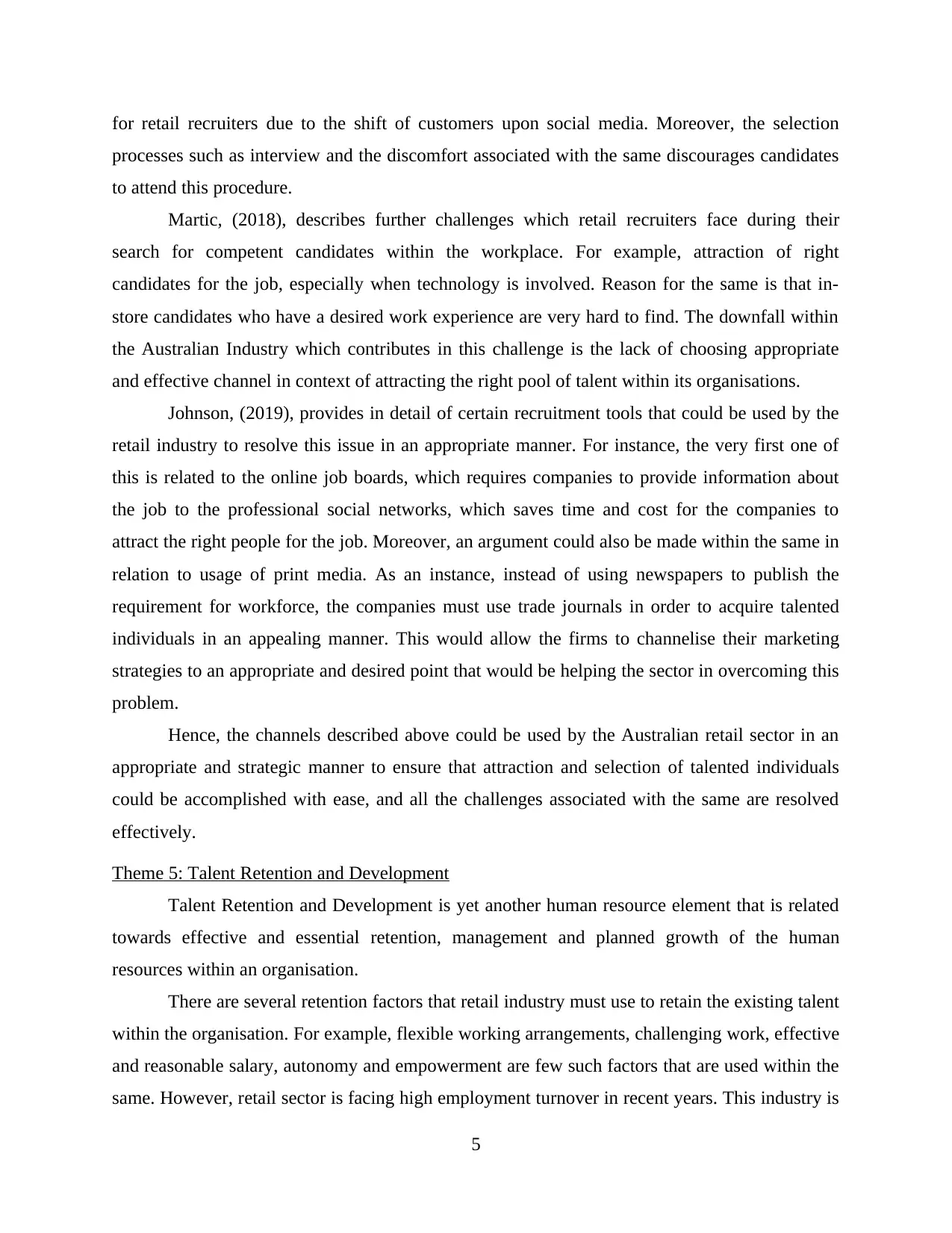
for retail recruiters due to the shift of customers upon social media. Moreover, the selection
processes such as interview and the discomfort associated with the same discourages candidates
to attend this procedure.
Martic, (2018), describes further challenges which retail recruiters face during their
search for competent candidates within the workplace. For example, attraction of right
candidates for the job, especially when technology is involved. Reason for the same is that in-
store candidates who have a desired work experience are very hard to find. The downfall within
the Australian Industry which contributes in this challenge is the lack of choosing appropriate
and effective channel in context of attracting the right pool of talent within its organisations.
Johnson, (2019), provides in detail of certain recruitment tools that could be used by the
retail industry to resolve this issue in an appropriate manner. For instance, the very first one of
this is related to the online job boards, which requires companies to provide information about
the job to the professional social networks, which saves time and cost for the companies to
attract the right people for the job. Moreover, an argument could also be made within the same in
relation to usage of print media. As an instance, instead of using newspapers to publish the
requirement for workforce, the companies must use trade journals in order to acquire talented
individuals in an appealing manner. This would allow the firms to channelise their marketing
strategies to an appropriate and desired point that would be helping the sector in overcoming this
problem.
Hence, the channels described above could be used by the Australian retail sector in an
appropriate and strategic manner to ensure that attraction and selection of talented individuals
could be accomplished with ease, and all the challenges associated with the same are resolved
effectively.
Theme 5: Talent Retention and Development
Talent Retention and Development is yet another human resource element that is related
towards effective and essential retention, management and planned growth of the human
resources within an organisation.
There are several retention factors that retail industry must use to retain the existing talent
within the organisation. For example, flexible working arrangements, challenging work, effective
and reasonable salary, autonomy and empowerment are few such factors that are used within the
same. However, retail sector is facing high employment turnover in recent years. This industry is
5
processes such as interview and the discomfort associated with the same discourages candidates
to attend this procedure.
Martic, (2018), describes further challenges which retail recruiters face during their
search for competent candidates within the workplace. For example, attraction of right
candidates for the job, especially when technology is involved. Reason for the same is that in-
store candidates who have a desired work experience are very hard to find. The downfall within
the Australian Industry which contributes in this challenge is the lack of choosing appropriate
and effective channel in context of attracting the right pool of talent within its organisations.
Johnson, (2019), provides in detail of certain recruitment tools that could be used by the
retail industry to resolve this issue in an appropriate manner. For instance, the very first one of
this is related to the online job boards, which requires companies to provide information about
the job to the professional social networks, which saves time and cost for the companies to
attract the right people for the job. Moreover, an argument could also be made within the same in
relation to usage of print media. As an instance, instead of using newspapers to publish the
requirement for workforce, the companies must use trade journals in order to acquire talented
individuals in an appealing manner. This would allow the firms to channelise their marketing
strategies to an appropriate and desired point that would be helping the sector in overcoming this
problem.
Hence, the channels described above could be used by the Australian retail sector in an
appropriate and strategic manner to ensure that attraction and selection of talented individuals
could be accomplished with ease, and all the challenges associated with the same are resolved
effectively.
Theme 5: Talent Retention and Development
Talent Retention and Development is yet another human resource element that is related
towards effective and essential retention, management and planned growth of the human
resources within an organisation.
There are several retention factors that retail industry must use to retain the existing talent
within the organisation. For example, flexible working arrangements, challenging work, effective
and reasonable salary, autonomy and empowerment are few such factors that are used within the
same. However, retail sector is facing high employment turnover in recent years. This industry is
5
Paraphrase This Document
Need a fresh take? Get an instant paraphrase of this document with our AI Paraphraser
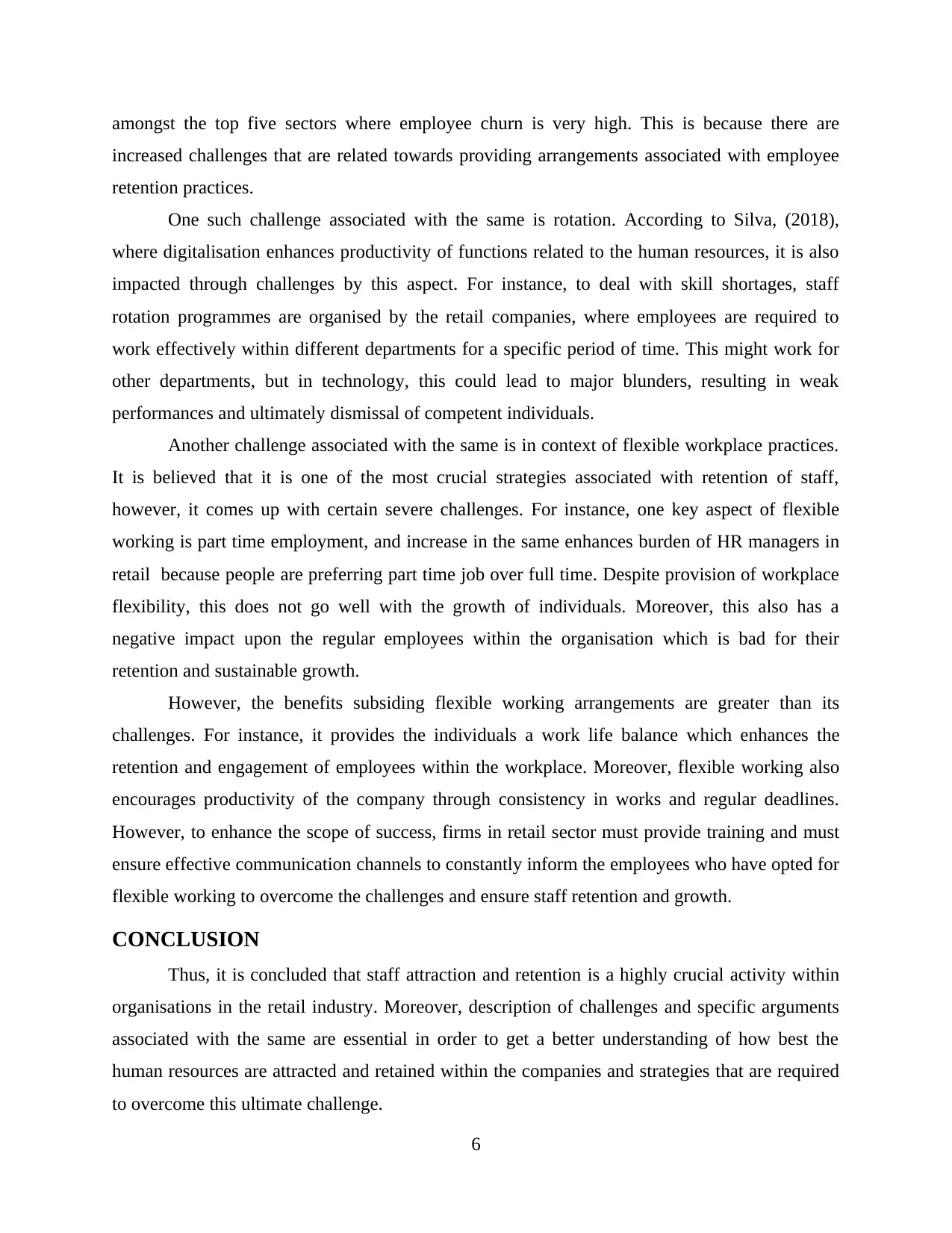
amongst the top five sectors where employee churn is very high. This is because there are
increased challenges that are related towards providing arrangements associated with employee
retention practices.
One such challenge associated with the same is rotation. According to Silva, (2018),
where digitalisation enhances productivity of functions related to the human resources, it is also
impacted through challenges by this aspect. For instance, to deal with skill shortages, staff
rotation programmes are organised by the retail companies, where employees are required to
work effectively within different departments for a specific period of time. This might work for
other departments, but in technology, this could lead to major blunders, resulting in weak
performances and ultimately dismissal of competent individuals.
Another challenge associated with the same is in context of flexible workplace practices.
It is believed that it is one of the most crucial strategies associated with retention of staff,
however, it comes up with certain severe challenges. For instance, one key aspect of flexible
working is part time employment, and increase in the same enhances burden of HR managers in
retail because people are preferring part time job over full time. Despite provision of workplace
flexibility, this does not go well with the growth of individuals. Moreover, this also has a
negative impact upon the regular employees within the organisation which is bad for their
retention and sustainable growth.
However, the benefits subsiding flexible working arrangements are greater than its
challenges. For instance, it provides the individuals a work life balance which enhances the
retention and engagement of employees within the workplace. Moreover, flexible working also
encourages productivity of the company through consistency in works and regular deadlines.
However, to enhance the scope of success, firms in retail sector must provide training and must
ensure effective communication channels to constantly inform the employees who have opted for
flexible working to overcome the challenges and ensure staff retention and growth.
CONCLUSION
Thus, it is concluded that staff attraction and retention is a highly crucial activity within
organisations in the retail industry. Moreover, description of challenges and specific arguments
associated with the same are essential in order to get a better understanding of how best the
human resources are attracted and retained within the companies and strategies that are required
to overcome this ultimate challenge.
6
increased challenges that are related towards providing arrangements associated with employee
retention practices.
One such challenge associated with the same is rotation. According to Silva, (2018),
where digitalisation enhances productivity of functions related to the human resources, it is also
impacted through challenges by this aspect. For instance, to deal with skill shortages, staff
rotation programmes are organised by the retail companies, where employees are required to
work effectively within different departments for a specific period of time. This might work for
other departments, but in technology, this could lead to major blunders, resulting in weak
performances and ultimately dismissal of competent individuals.
Another challenge associated with the same is in context of flexible workplace practices.
It is believed that it is one of the most crucial strategies associated with retention of staff,
however, it comes up with certain severe challenges. For instance, one key aspect of flexible
working is part time employment, and increase in the same enhances burden of HR managers in
retail because people are preferring part time job over full time. Despite provision of workplace
flexibility, this does not go well with the growth of individuals. Moreover, this also has a
negative impact upon the regular employees within the organisation which is bad for their
retention and sustainable growth.
However, the benefits subsiding flexible working arrangements are greater than its
challenges. For instance, it provides the individuals a work life balance which enhances the
retention and engagement of employees within the workplace. Moreover, flexible working also
encourages productivity of the company through consistency in works and regular deadlines.
However, to enhance the scope of success, firms in retail sector must provide training and must
ensure effective communication channels to constantly inform the employees who have opted for
flexible working to overcome the challenges and ensure staff retention and growth.
CONCLUSION
Thus, it is concluded that staff attraction and retention is a highly crucial activity within
organisations in the retail industry. Moreover, description of challenges and specific arguments
associated with the same are essential in order to get a better understanding of how best the
human resources are attracted and retained within the companies and strategies that are required
to overcome this ultimate challenge.
6
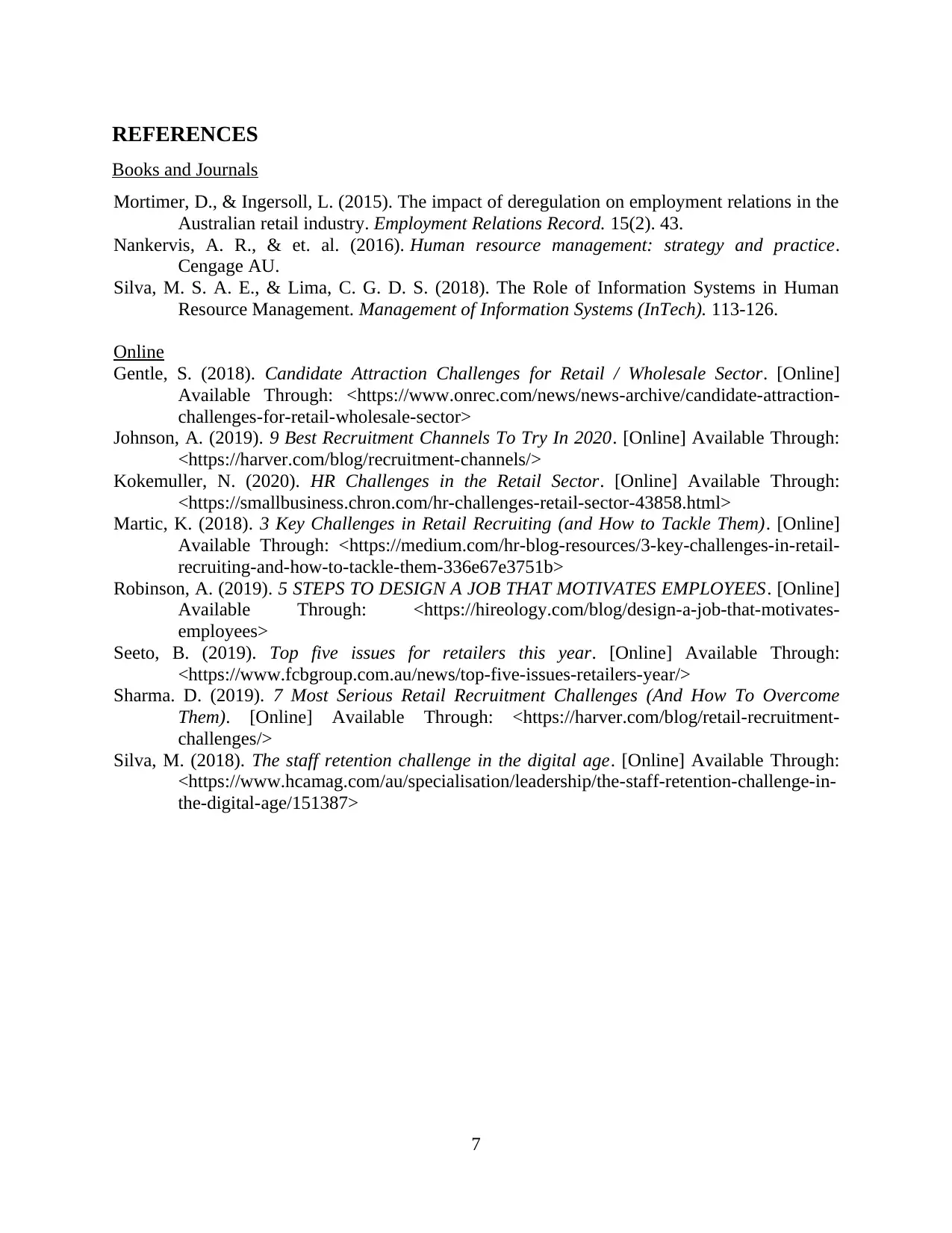
REFERENCES
Books and Journals
Mortimer, D., & Ingersoll, L. (2015). The impact of deregulation on employment relations in the
Australian retail industry. Employment Relations Record. 15(2). 43.
Nankervis, A. R., & et. al. (2016). Human resource management: strategy and practice.
Cengage AU.
Silva, M. S. A. E., & Lima, C. G. D. S. (2018). The Role of Information Systems in Human
Resource Management. Management of Information Systems (InTech). 113-126.
Online
Gentle, S. (2018). Candidate Attraction Challenges for Retail / Wholesale Sector. [Online]
Available Through: <https://www.onrec.com/news/news-archive/candidate-attraction-
challenges-for-retail-wholesale-sector>
Johnson, A. (2019). 9 Best Recruitment Channels To Try In 2020. [Online] Available Through:
<https://harver.com/blog/recruitment-channels/>
Kokemuller, N. (2020). HR Challenges in the Retail Sector. [Online] Available Through:
<https://smallbusiness.chron.com/hr-challenges-retail-sector-43858.html>
Martic, K. (2018). 3 Key Challenges in Retail Recruiting (and How to Tackle Them). [Online]
Available Through: <https://medium.com/hr-blog-resources/3-key-challenges-in-retail-
recruiting-and-how-to-tackle-them-336e67e3751b>
Robinson, A. (2019). 5 STEPS TO DESIGN A JOB THAT MOTIVATES EMPLOYEES. [Online]
Available Through: <https://hireology.com/blog/design-a-job-that-motivates-
employees>
Seeto, B. (2019). Top five issues for retailers this year. [Online] Available Through:
<https://www.fcbgroup.com.au/news/top-five-issues-retailers-year/>
Sharma. D. (2019). 7 Most Serious Retail Recruitment Challenges (And How To Overcome
Them). [Online] Available Through: <https://harver.com/blog/retail-recruitment-
challenges/>
Silva, M. (2018). The staff retention challenge in the digital age. [Online] Available Through:
<https://www.hcamag.com/au/specialisation/leadership/the-staff-retention-challenge-in-
the-digital-age/151387>
7
Books and Journals
Mortimer, D., & Ingersoll, L. (2015). The impact of deregulation on employment relations in the
Australian retail industry. Employment Relations Record. 15(2). 43.
Nankervis, A. R., & et. al. (2016). Human resource management: strategy and practice.
Cengage AU.
Silva, M. S. A. E., & Lima, C. G. D. S. (2018). The Role of Information Systems in Human
Resource Management. Management of Information Systems (InTech). 113-126.
Online
Gentle, S. (2018). Candidate Attraction Challenges for Retail / Wholesale Sector. [Online]
Available Through: <https://www.onrec.com/news/news-archive/candidate-attraction-
challenges-for-retail-wholesale-sector>
Johnson, A. (2019). 9 Best Recruitment Channels To Try In 2020. [Online] Available Through:
<https://harver.com/blog/recruitment-channels/>
Kokemuller, N. (2020). HR Challenges in the Retail Sector. [Online] Available Through:
<https://smallbusiness.chron.com/hr-challenges-retail-sector-43858.html>
Martic, K. (2018). 3 Key Challenges in Retail Recruiting (and How to Tackle Them). [Online]
Available Through: <https://medium.com/hr-blog-resources/3-key-challenges-in-retail-
recruiting-and-how-to-tackle-them-336e67e3751b>
Robinson, A. (2019). 5 STEPS TO DESIGN A JOB THAT MOTIVATES EMPLOYEES. [Online]
Available Through: <https://hireology.com/blog/design-a-job-that-motivates-
employees>
Seeto, B. (2019). Top five issues for retailers this year. [Online] Available Through:
<https://www.fcbgroup.com.au/news/top-five-issues-retailers-year/>
Sharma. D. (2019). 7 Most Serious Retail Recruitment Challenges (And How To Overcome
Them). [Online] Available Through: <https://harver.com/blog/retail-recruitment-
challenges/>
Silva, M. (2018). The staff retention challenge in the digital age. [Online] Available Through:
<https://www.hcamag.com/au/specialisation/leadership/the-staff-retention-challenge-in-
the-digital-age/151387>
7
⊘ This is a preview!⊘
Do you want full access?
Subscribe today to unlock all pages.

Trusted by 1+ million students worldwide
1 out of 9
Related Documents
Your All-in-One AI-Powered Toolkit for Academic Success.
+13062052269
info@desklib.com
Available 24*7 on WhatsApp / Email
![[object Object]](/_next/static/media/star-bottom.7253800d.svg)
Unlock your academic potential
Copyright © 2020–2025 A2Z Services. All Rights Reserved. Developed and managed by ZUCOL.




